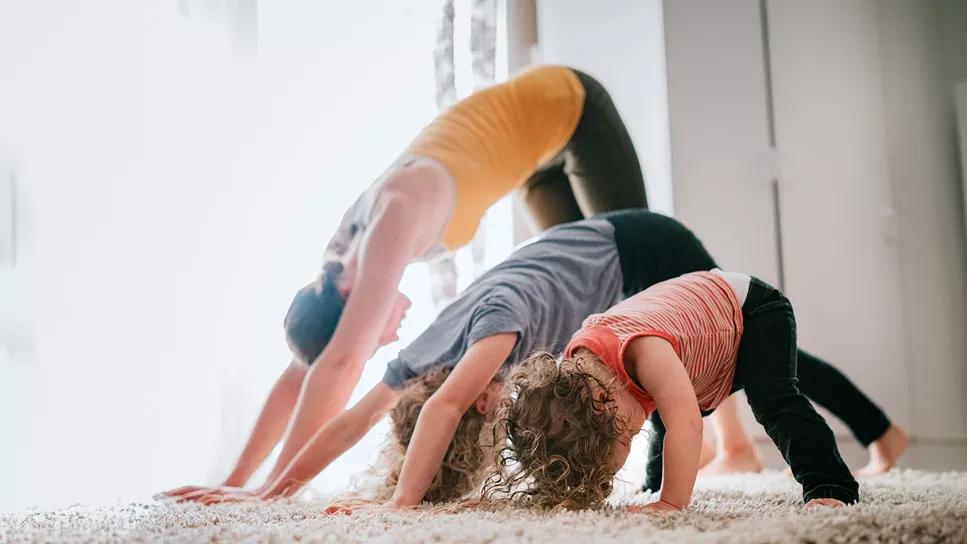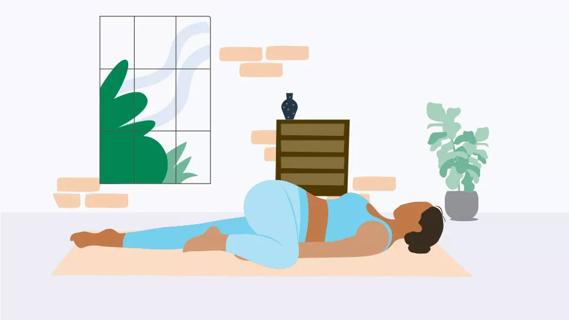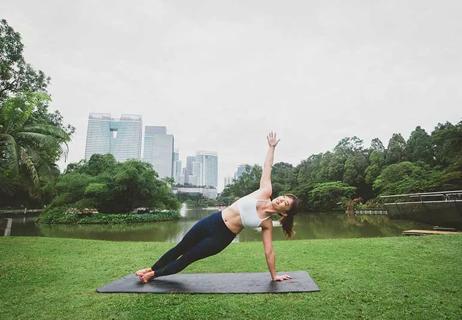Kids’ yoga can help kiddos become more aware of their physical, mental and emotional selves

Yoga is one of the most common movement practices in the United States. And for good reason.
Advertisement
Cleveland Clinic is a non-profit academic medical center. Advertising on our site helps support our mission. We do not endorse non-Cleveland Clinic products or services. Policy
Yoga can help you live more mindfully. It can improve mental health and self-esteem. It can strengthen your body and improve flexibility.
And it’s not just adults who can reap the benefits of practicing yoga. Yoga can also have big health benefits for kids.
“Yoga is a great way for kids to relax, connect with themselves, and start to better understand their bodies and their emotions,” says yoga instructor Valerie Williams, RYT 200.
How do kids benefit from yoga? And how can you get started with a kids’ yoga practice? Let’s dive in.
Some people may immediately picture yoga as a physical practice — contorting your body into pretzel-esque shapes or bending so deeply that your nose touches your knees. But physical postures are but one tool used in yoga practices.
In essence, yoga is a practice that strives to bring balance to your mind and body. That includes poses, sure, but also breathing and relaxing meditation.
And that trifecta of physical movement, breathing and mindfulness can bring on physical and emotional benefits in adults and kids alike.
Williams says the benefits that she sees when teaching yoga to kids include:
Advertisement
Similar results have been suggested by researchers, with one study showing that second- and third-graders enrolled in a 10-week yoga class showed less stress. They also had improved social interactions, attention spans, coping skills, confidence, academic performance and mood.
Anytime is the right time for kids (and adults) to start getting into yoga. That’s because yoga can be modified to work for just about anyone — regardless of their age or ability.
“Even as toddlers, kids can start to learn about using their breath to help them relax. They can start to understand that when they reach their arms up over their heads, they can feel a stretch,” Williams explains. “Breathing and intentional movement are yoga concepts that even little kids can learn from.”
Williams shares some of her favorite poses to try with kids and why she finds them to be beneficial.
Note: As you begin a yoga journey with little kids, it’s important to remind them that yoga poses should never hurt. Let them know that it’s safe for them to push their bodies to feel a bit of a stretch, but not more.
Ages: Toddlers and older.
How to do it:
Top benefit: Relaxation.
“I recommend child’s pose for everyone, from preschoolers to older adults,” Williams says. “Child’s pose can help to bring you comfort and help you find calm.”
Why?
Deep forward bending activates the nerves in your lower back that trigger your parasympathetic nervous system to take over. That’s your body’s “rest and restore” mode.
"When we press our thighs against our belly, it can help to activate our parasympathetic nervous system, shutting off our fight-or-flight response. When we exit fight or flight, that's when the ‘rest and restore’ part of our nervous system takes over,” Williams explains. “So, in a way, poses like child’s pose can help our bodies to physically and emotionally heal and recover.”
Ages: Toddlers and older.
How to do it:
Benefits: Emotional opening. Back strengthening. Flexibility.
Advertisement
“I like poses with a lot of back bends for older kids because these kinds of movements can teach us to open up our hearts,” Williams notes. “Emotions like compassion, trust and forgiveness are held in the heart. So, doing poses where we’re pushing our chests forward and arching our backs, we can encourage more loving emotions.”
Ages: Toddlers and older.
How to do it:
Top benefit: Confidence.
“Star pose is one of my favorites for little kids,” Williams shares. “Confidence can be hard for kids, and poses like star pose encourage them to take up space and bring on feelings of confidence in themselves. It’s like claiming your place in the world.”
Ages: Toddlers and older.
How to do it:
Benefits: Inversion. Relaxation. Stretching.
Advertisement
Downward-facing dog is a staple of many yoga practices. It can help encourage strengthening, stretching and flexibility. It’s also a restorative pose because being upside down (inverted) can promote blood flow, which can work to both energize and calm your body.
Ages: Elementary school and older.
How to do it:
Benefits: Balance. Concentration.
“Balancing poses are great for older kids because being balanced physically can help bring balance mentally,” Williams points out. “Kids are learning about their place in the world. And sometimes they can get kind of off-center. It can be hard to balance school and home and sports and all the things that kids are doing and learning. So, I think practicing a lot of balancing poses is really good for older kids.”
Ages: Elementary school and older.
How to do it:
Advertisement
Benefits: Confidence. Strengthening.
“Warrior 1 is all about claiming space, building confidence and building strength,” Williams says. “It can help kids feel strong and powerful.”
Ages: Elementary school and older.
How to do it:
Benefits: Confidence. Strengthening.
“Warrior 2 can be a tougher pose to hold, and kids might start to feel their muscles start to shake a bit or get warm,” Williams notes. “Those sensations can help to bring more awareness to all that their bodies are capable of. They might think, ‘Oh, I feel strong here.’”
Ages: Elementary school and older.
How to do it:
Benefits: Balance. Strengthening.
“I also like doing this pose with kids as a partner exercise,” Williams suggests. “As the child balances on one leg, a friend or caregiver can hold their hands to help keep them steady.”
Ages: Elementary school and older.
How to do it:
Benefits: Relaxation. Release. Stretch.
Like other inverted positions, ragdoll encourages blood flow. Having your head pointed down can also help to calm the mind and relieve stress. Ragdoll is also good for releasing tension in tight hamstrings and relieving pressure in your back.
Ages: Elementary school and older.
How to do it:
Benefits: Trust. Connection. Confidence. Core strength. Fun!
“At its core, yoga is about connection — connection between your body, mind and spirit,” Williams shares. “So, partner poses can also help kids connect with each other and learn to hold space with other people and work together.”
Ages: Elementary school and older.
How to do it:
Benefits: Connection. Flexibility.
“We hold a lot of tension in our spines, and most of our day-to-day movements don’t encourage twisting our back. Twisting is a great exercise for kids and adults alike,” Williams adds.
Ages: Elementary school and older.
How to do it:
Benefits: Connection. Confidence. Strength.
“Chair pose can be a challenging pose, so when you’re able to do it, it’s a big confidence boost,” Williams points out. “Partner chair pose encourages kids to literally hold each other up, which builds connection and trust. It’s like, ‘We’re in this tough thing together.’”
Remember that yoga isn’t just about the physical movements we make; it’s also rooted in creating balance between your body and your mind.
Yoga practitioners do this by using their breath and encouraging mindfulness. Mindfulness is the practice of being “in the moment” — focusing on the here and now, not the past or the future, but what you’re experiencing in the present.
“Most kids aren’t going to sit and meditate for a half hour. But having them practice taking just a minute out of their day to pause and focus on their breath can be incredibly beneficial,” Williams recommends.
“When we can slow down and be mindful, we start to become fully present in the moment. And when we can do that, we are able to discover thoughts, emotions and perceptions and start to understand them. This can prevent a child from shifting towards negative behavior, or a rash decision, simply because they couldn't process how they felt in that moment. “
Williams shares a few ways she likes to practice breathing and mindfulness with kids.
When practicing yoga poses (or anytime, really), using standard yoga breath can be restorative and calming.
Try this:
Williams suggests “busy bee breath” to help give kids a spurt of energy when they’re feeling sluggish or unfocused.
Here’s how to do it:
Box breath or equal-part breath, can help you focus and relax. Or, as Williams says, “come back to center.”
Here’s how to do it:
Kids can easily get distracted by all that’s happening around them (happens with us, grownups, too, right?). And when we’re distracted, it’s hard to notice what you’re feeling and what you’re thinking. You’re not in the moment, you’re way out in left field somewhere.
Kids can start learning to get back to reality with a simple meditation technique called the five senses. You can prompt them to use each of their senses to encourage them to get in touch with their surroundings and live in the moment.
“Using the five senses technique gives kids (or adults) a chance to slow down and notice the subtle things,” Williams shares. “And with practice that can help them notice those subtle feelings and subtle movements when they come up. Eventually, they can use this technique to manage bigger emotions and challenges as they come up.”
Williams suggests teaching kids to use simple affirmations to build self-esteem and self-awareness. Researchers say self-affirmation can improve learning, health and relationships.
Help your child develop a positive affirmation they can say to themselves at times of self-doubt. That might be something like:
Yoga is a lifelong practice that, especially when started early, can be hugely beneficial to kids throughout their lives. Namaste.
Learn more about our editorial process.
Advertisement

This gentle yoga stretch supports your spine, strengthens your core and calms your mind

Focus on inhaling and exhaling through 12 steps of a complete sequence

Stand tall and feel grounded with this foundational yoga pose

This transitional and restorative yoga pose provides a full-body stretch

Somatic yoga focuses on the sensation and experience of movement — not striking perfect poses

Balasana, or child’s pose, is a restorative full-body yoga technique

This mindful practice is designed to give you mental and physical relaxation

You can work more than your abdominals

Babies can get congested easily, but you can calm their cough by keeping them hydrated, using nasal drops and running a humidifier

Weight loss may cause loose, sagging skin and muscle loss to your rear

Several conditions, like vitiligo and fungal infection, can cause a loss of pigmentation, leading to white spots or patches on your skin